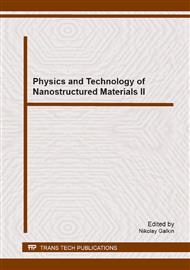p.42
p.47
p.51
p.56
p.60
p.65
p.71
p.80
p.86
Multi-Walled Carbon Nanotubes Synthesized by Methane Pyrolysis: Structure and Magnetic Properties
Abstract:
The structure and magnetic properties of multi-walled carbon nanotubes produced by catalytic pyrolysis of methane have been investigated by means of mutually complementary physical methods. The average sizes and number of carbon layers forming nanotubes, smearing of the density of states near the Fermi level, degeneracy temperature of gas of extrinsic current carriers, concentrations of localized spins and extrinsic two-dimensional current carriers have been determined. The conclusion has been drawn that ferromagnetic nanoparticles are present in the inner regions of nanotubes, including their tubular cavities. The difference in electronic structure near the Fermi level for carbon nanotubes and ordered graphite has been revealed. The possible reason is that the electronic states near zigzag-type sites of ends as well as edges of linear structural defects in nanotubes make greater contribution to the spectrum than that from similar sites of graphite.
Info:
Periodical:
Pages:
60-64
Citation:
Online since:
March 2014
Authors:
Price:
Сopyright:
© 2014 Trans Tech Publications Ltd. All Rights Reserved
Share:
Citation:


